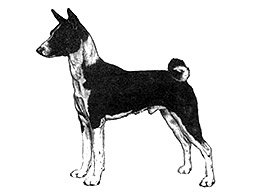Basenji Breed Standard
Last updated: 23 Jan 2015
A breed standard is the guideline which describes the ideal characteristics, temperament, and appearance of a breed and ensures that the breed is fit for function with soundness essential. Breeders and judges should at all times be mindful of features which could be detrimental in any way to the health, welfare or soundness of this breed.

Kennel Club, London 1994
FCI Standard No 43
Amended May 2000
-
Group:
Group 4 (Hounds)
-
History:
-
General Appearance:
Lightly built, finely boned aristocratic-looking animal, high on leg compared with its length, always poised, alert and intelligent. Wrinkled head, with pricked ears, proudly carried on a well-arched neck. Deep brisket runs up into a definite waist, tail tightly curled presenting a picture of a well balanced dog of gazelle-like grace.
-
Characteristics:
Barkless but not mute, its own special noise of mixture of a chortle and a yodel. Remarkable for its cleanliness in every way.
-
Temperament:
An intelligent, independent, but affectionate and alert breed. Can be aloof with strangers.
-
Head And Skull:
Flat, well-chiselled and medium width, tapering towards nose, with slight stop. Distance from top of head to stop slightly more than from stop to tip of nose. Side lines of skull taper gradually towards mouth, giving a clean-cheeked appearance. Fine and profuse wrinkles appearing on forehead when ears pricked, side wrinkles desirable but not exaggerated into dewlap. Wrinkles more noticeable in puppies, but because of lack of shadowing, not as noticeable in tri-colours; black nose desirable.
-
Eyes:
Dark, almond-shaped, obliquely set, far-seeing and rather inscrutable in expression.
-
Ears:
Small, pointed, erect and slightly hooded, of fine texture, set well forward on top of head, tip of ear nearer centre of skull than outside base.
-
Mouth:
Jaws strong, with perfect, regular and complete scissor bite, i.e. Upper teeth closely overlapping lower teeth and set square to the jaws.
-
Neck:
Strong and of good length, without thickness, well crested and slightly full at base of throat with a graceful curve accentuating crest. Well-set into shoulders giving head a 'lofty' carriage.
-
Forequarters:
Shoulders well laid back, muscular, not loaded. Elbows tucked in against brisket. When viewed from front, elbows in line with ribs and legs should continue in a straight line to ground giving a medium front. Forelegs straight with fine bone and very long fore-arms. Pasterns good length, straight and flexible.
-
Body:
Balanced with short, level back. Ribs well sprung, deep and oval. Loin short coupled, deep brisket running up into definite waist.
-
Hindquarters:
Strong and muscular, hocks well let down, turned neither in nor out, with long second thighs and moderately bent stifles.
-
Feet:
Small, narrow and compact, with deep pads, well arched toes and short nails.
-
Tail:
High set, with posterior curve of buttock extending beyond root of tail giving a reachy appearance to hindquarters. Curls tightly over spine and lies closely to thigh with a single or double curl.
-
Gait/Movement:
Legs carried straight forward with a swift long tireless swinging stride.
-
Coat:
Short, sleek and close, very fine. Skin very pliant.
-
Colour:
Pure black and white, red and white, black tan and white with tan melon pips and mask, black, tan and white. Brindle, red background with black stripes, the more clearly defined the stripes the better. The white should be on feet, chest and tail tip. White legs, blaze and white collar optional.
-
Sizes:
Ideal height:
Dogs 43 cms (17 ins) at withers
Bitches 40 cm (16 ins) at withers
Ideal weight:
Dogs 11 kg (24 lbs)
Bitches 9.5 kg ( 21 lbs)
-
Faults:
Any departure from the foregoing points should be considered a fault and the seriousness with which the fault should be regarded should be in exact proportion to its degree and its effect upon the health and welfare of the dog.
-
Notes:
Male animals should have two apparently normal testicles fully descended into the scrotum.
 For owners
For owners
 Members
Members
 Dogs Australia is a not-for-profit organisation advocating for the preservation of purebred dogs through ethical breeding.
It champions the highest standard of animal welfare through education and fostering dog-loving communities.
Internationally recognised and established in 1958 as the Australian National Kennel Council (ANKC),
the organisation promotes responsible dog ownership; maintains the ORCHID* heritable canine diseases database;
funds research into canine diseases; and supports state and territory-based member bodies.
Dogs Australia promotes breed conformation shows and community sports for dogs that fulfil a breed’s natural instincts.
Dogs Australia is a not-for-profit organisation advocating for the preservation of purebred dogs through ethical breeding.
It champions the highest standard of animal welfare through education and fostering dog-loving communities.
Internationally recognised and established in 1958 as the Australian National Kennel Council (ANKC),
the organisation promotes responsible dog ownership; maintains the ORCHID* heritable canine diseases database;
funds research into canine diseases; and supports state and territory-based member bodies.
Dogs Australia promotes breed conformation shows and community sports for dogs that fulfil a breed’s natural instincts.







